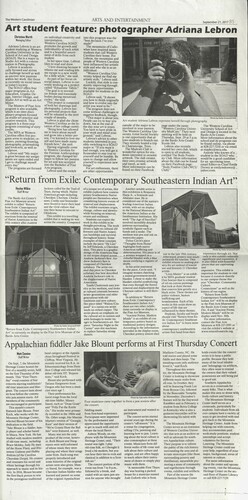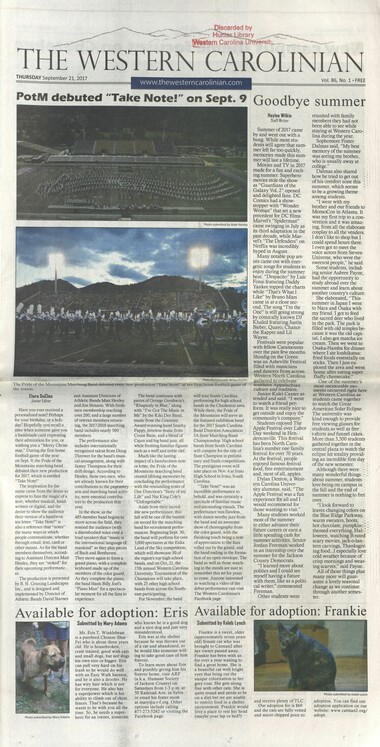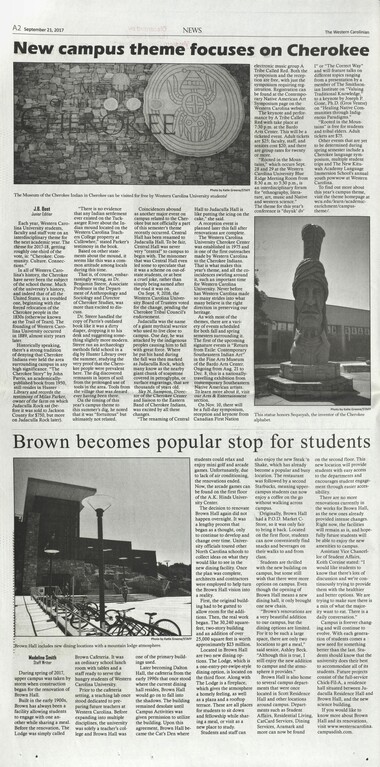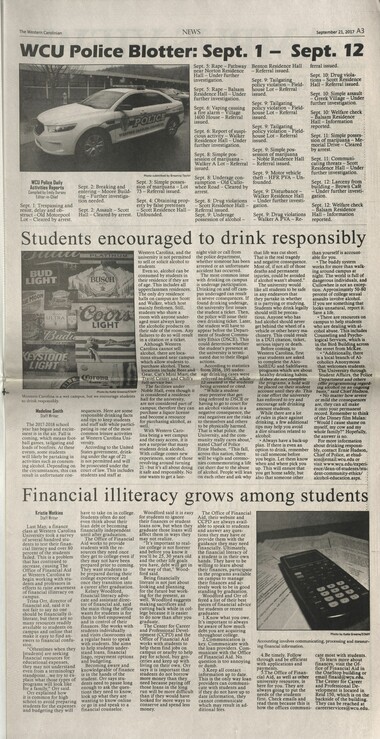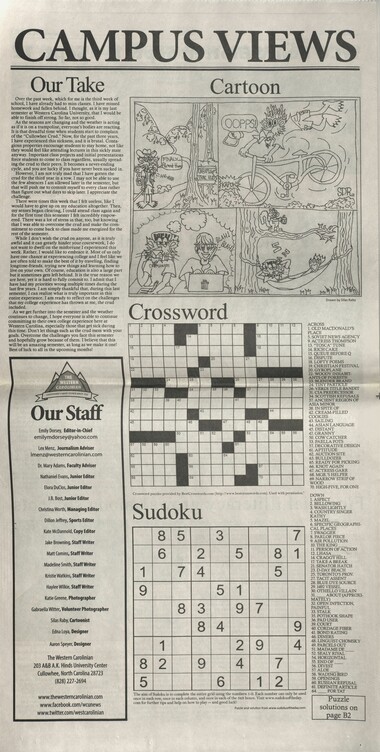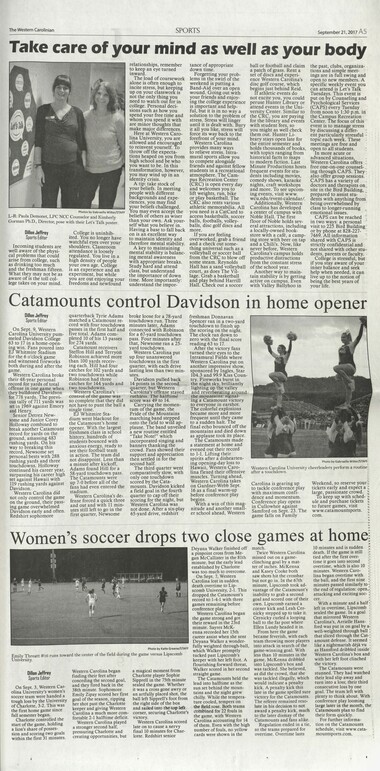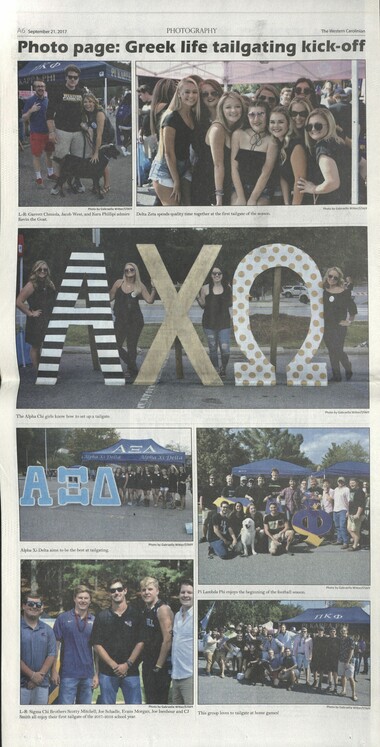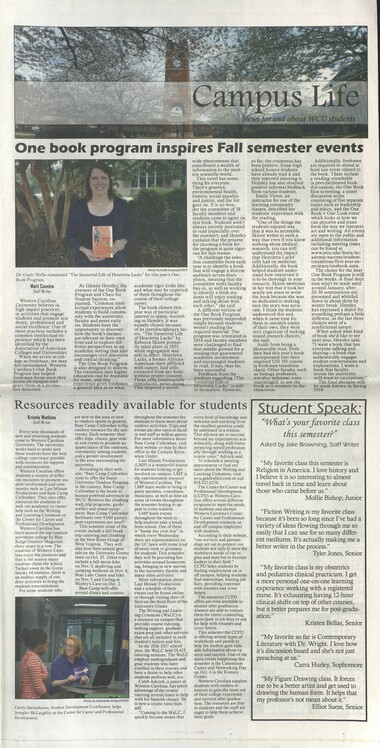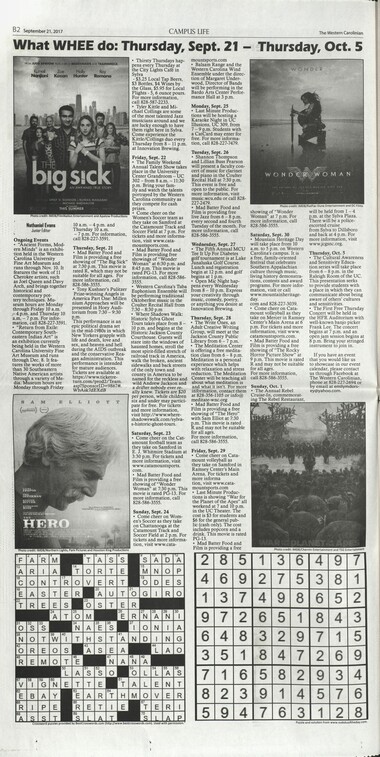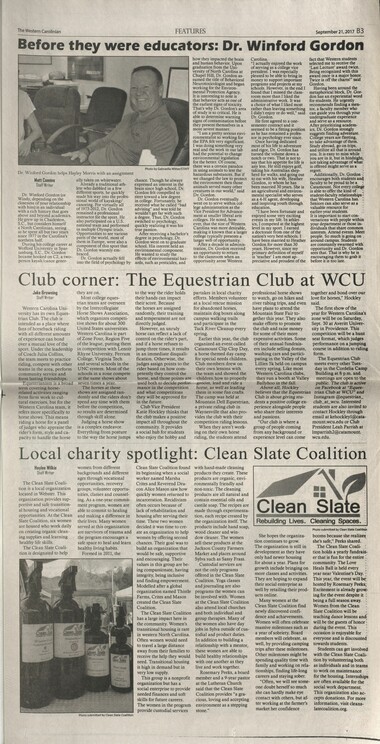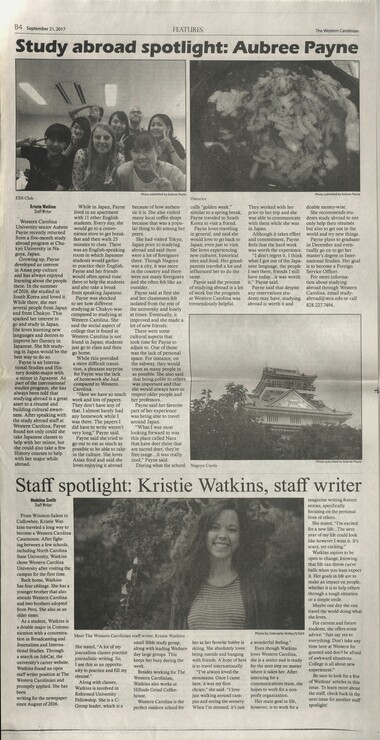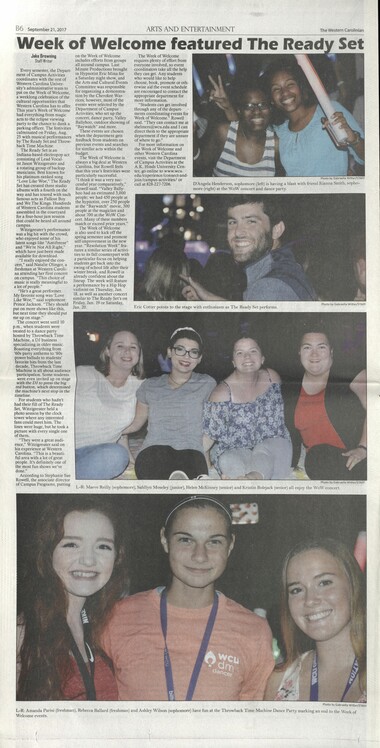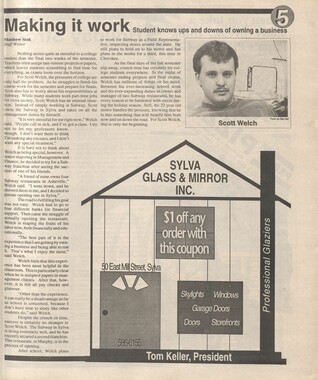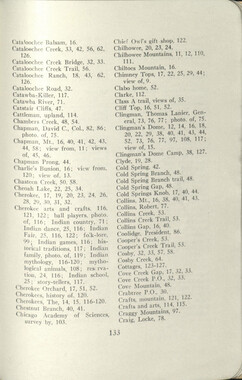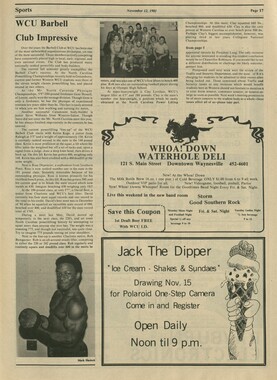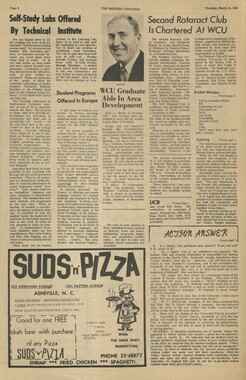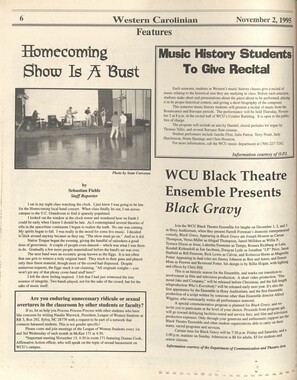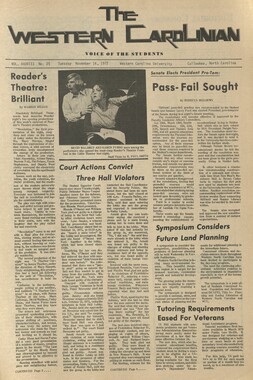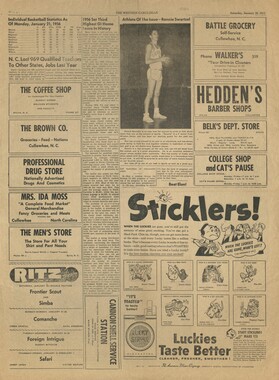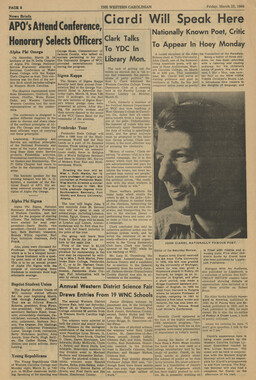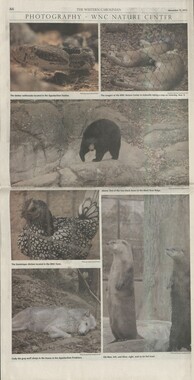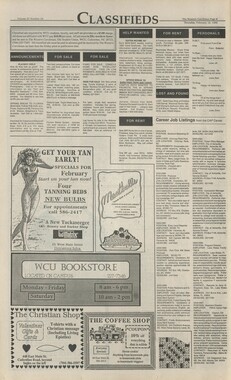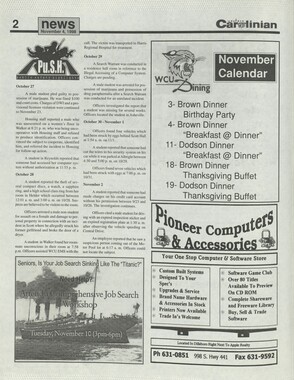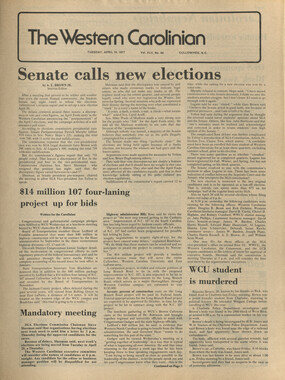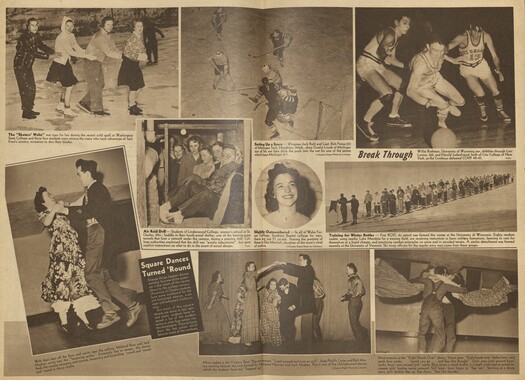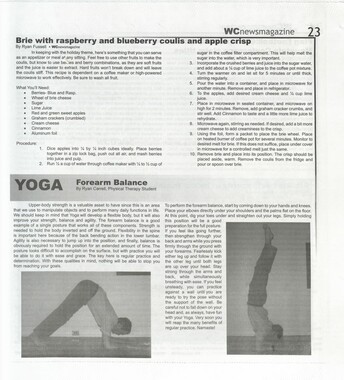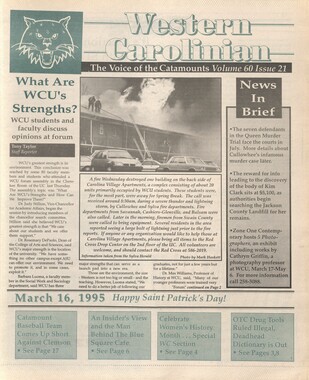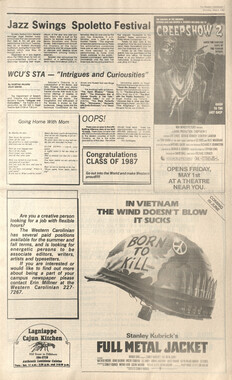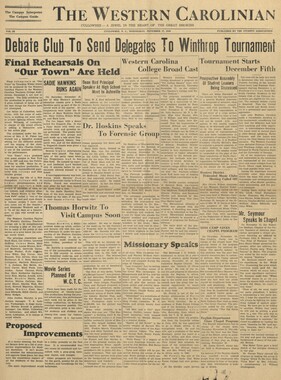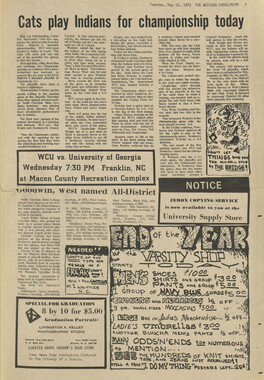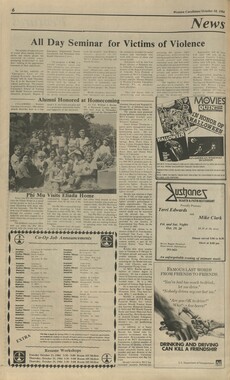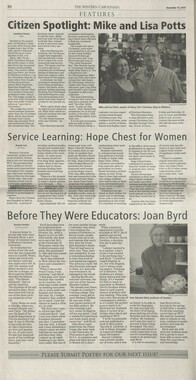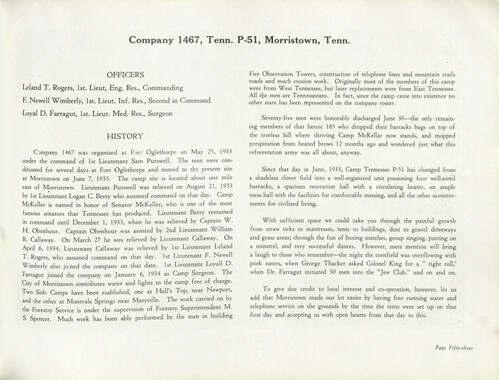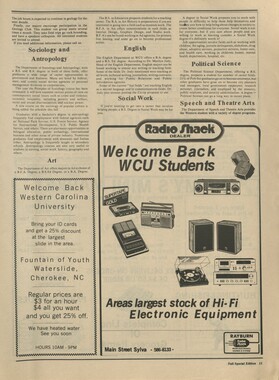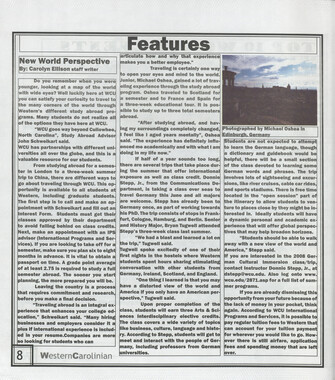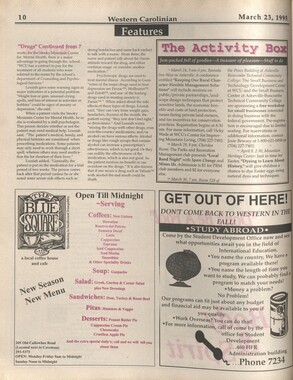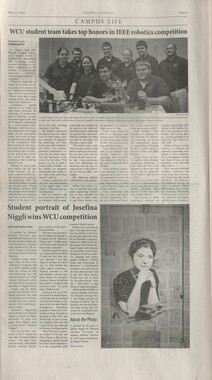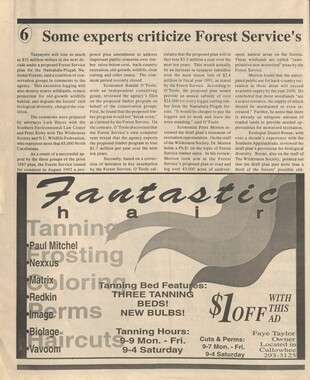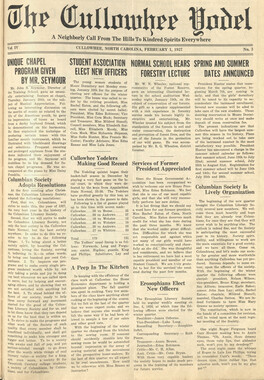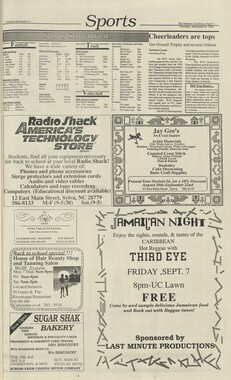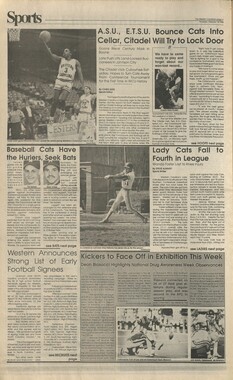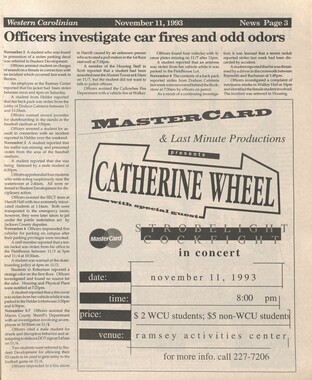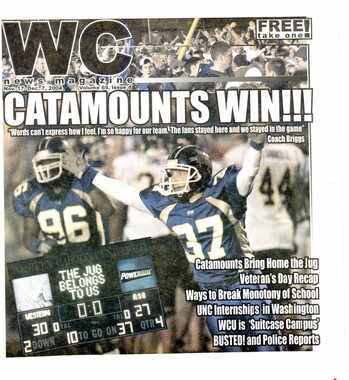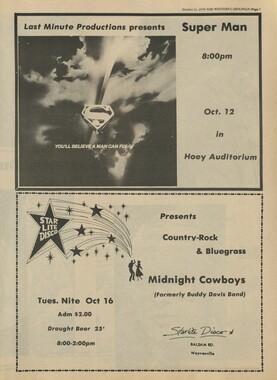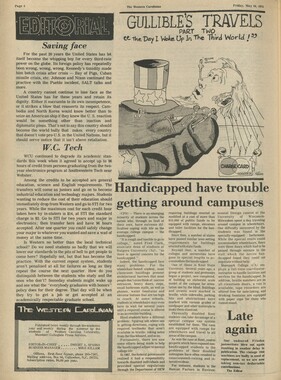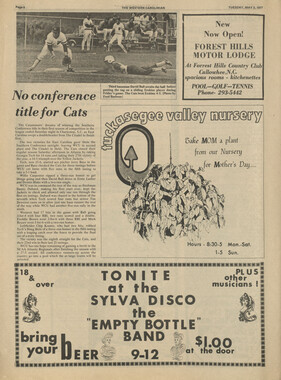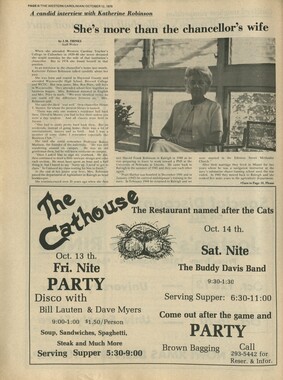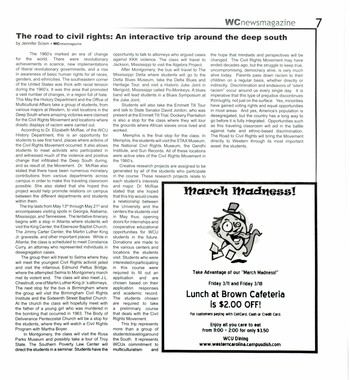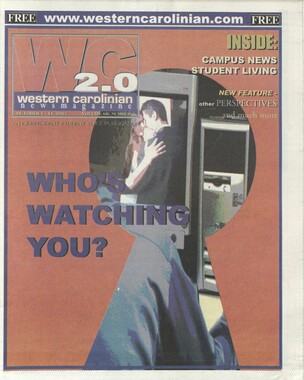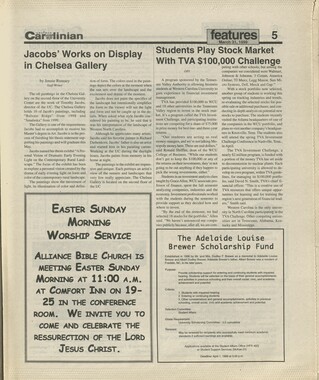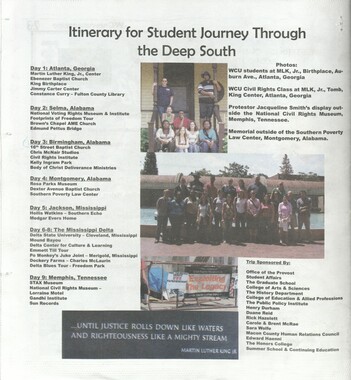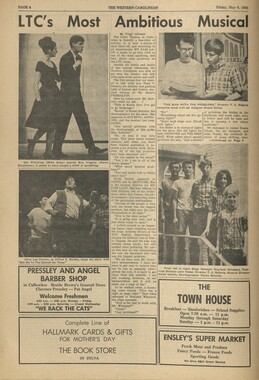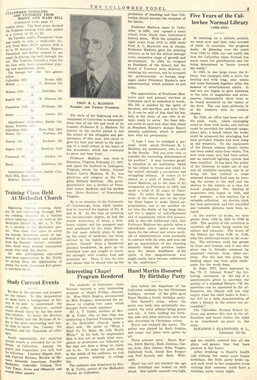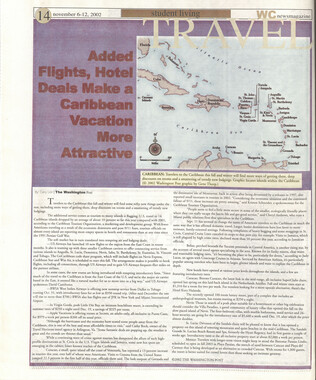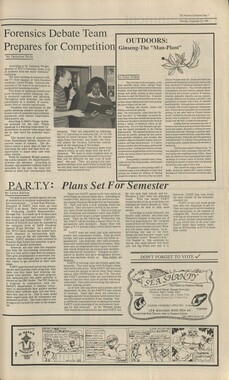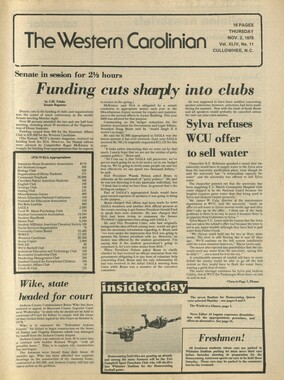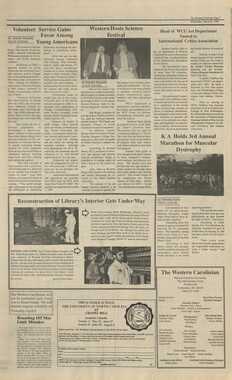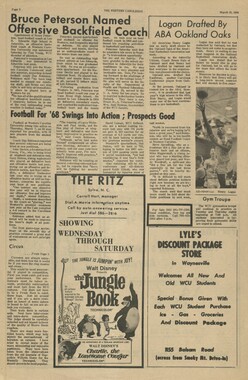Western Carolina University (20)
View all
- Canton Champion Fibre Company (2308)
- Cherokee Traditions (291)
- Civil War in Southern Appalachia (165)
- Craft Revival (1942)
- Great Smoky Mountains - A Park for America (2946)
- Highlights from Western Carolina University (430)
- Horace Kephart (941)
- Journeys Through Jackson (159)
- LGBTQIA+ Archive of Jackson County (85)
- Oral Histories of Western North Carolina (314)
- Picturing Appalachia (6873)
- Stories of Mountain Folk (413)
- Travel Western North Carolina (160)
- Western Carolina University Fine Art Museum Vitreograph Collection (129)
- Western Carolina University Herbarium (92)
- Western Carolina University: Making Memories (738)
- Western Carolina University Publications (2491)
- Western Carolina University Restricted Electronic Theses and Dissertations (146)
- Western North Carolina Regional Maps (71)
- World War II in Southern Appalachia (131)
University of North Carolina Asheville (6)
View all
- Allanstand Cottage Industries (62)
- Appalachian National Park Association (53)
- Bennett, Kelly, 1890-1974 (1463)
- Berry, Walter (76)
- Brasstown Carvers (40)
- Carver, George Washington, 1864?-1943 (26)
- Cathey, Joseph, 1803-1874 (1)
- Champion Fibre Company (233)
- Champion Paper and Fibre Company (297)
- Cherokee Indian Fair Association (16)
- Cherokee Language Program (22)
- Crowe, Amanda (40)
- Edmonston, Thomas Benton, 1842-1907 (7)
- Ensley, A. L. (Abraham Lincoln), 1865-1948 (275)
- Fromer, Irving Rhodes, 1913-1994 (70)
- George Butz (BFS 1907) (46)
- Goodrich, Frances Louisa (120)
- Grant, George Alexander, 1891-1964 (96)
- Heard, Marian Gladys (60)
- Kephart, Calvin, 1883-1969 (15)
- Kephart, Horace, 1862-1931 (313)
- Kephart, Laura, 1862-1954 (39)
- Laney, Gideon Thomas, 1889-1976 (439)
- Masa, George, 1881-1933 (61)
- McElhinney, William Julian, 1896-1953 (44)
- Niggli, Josephina, 1910-1983 (10)
- North Carolina Park Commission (105)
- Osborne, Kezia Stradley (9)
- Owens, Samuel Robert, 1918-1995 (11)
- Penland Weavers and Potters (36)
- Roberts, Vivienne (15)
- Roth, Albert, 1890-1974 (142)
- Schenck, Carl Alwin, 1868-1955 (1)
- Sherrill's Photography Studio (2565)
- Southern Highland Handicraft Guild (127)
- Southern Highlanders, Inc. (71)
- Stalcup, Jesse Bryson (46)
- Stearns, I. K. (213)
- Thompson, James Edward, 1880-1976 (226)
- United States. Indian Arts and Crafts Board (130)
- USFS (683)
- Vance, Zebulon Baird, 1830-1894 (1)
- Weaver, Zebulon, 1872-1948 (58)
- Western Carolina College (230)
- Western Carolina Teachers College (282)
- Western Carolina University (2008)
- Western Carolina University. Mountain Heritage Center (18)
- Whitman, Walt, 1819-1892 (10)
- Wilburn, Hiram Coleman, 1880-1967 (73)
- Williams, Isadora (3)
- Cain, Doreyl Ammons (0)
- Crittenden, Lorraine (0)
- Rhodes, Judy (0)
- Smith, Edward Clark (0)
- Appalachian Region, Southern (2569)
- Asheville (N.C.) (1923)
- Avery County (N.C.) (26)
- Blount County (Tenn.) (195)
- Buncombe County (N.C.) (1672)
- Cherokee County (N.C.) (283)
- Clay County (N.C.) (555)
- Graham County (N.C.) (236)
- Great Smoky Mountains National Park (N.C. and Tenn.) (519)
- Haywood County (N.C.) (3569)
- Henderson County (N.C.) (70)
- Jackson County (N.C.) (4912)
- Knox County (Tenn.) (35)
- Knoxville (Tenn.) (13)
- Lake Santeetlah (N.C.) (10)
- Macon County (N.C.) (420)
- Madison County (N.C.) (215)
- McDowell County (N.C.) (39)
- Mitchell County (N.C.) (132)
- Polk County (N.C.) (35)
- Qualla Boundary (982)
- Rutherford County (N.C.) (76)
- Swain County (N.C.) (2182)
- Transylvania County (N.C.) (270)
- Watauga County (N.C.) (12)
- Waynesville (N.C.) (86)
- Yancey County (N.C.) (72)
- Aerial Photographs (3)
- Aerial Views (60)
- Albums (books) (4)
- Articles (1)
- Artifacts (object Genre) (228)
- Bibliographies (1)
- Biography (general Genre) (2)
- Cards (information Artifacts) (38)
- Clippings (information Artifacts) (191)
- Copybooks (instructional Materials) (3)
- Crafts (art Genres) (622)
- Depictions (visual Works) (21)
- Design Drawings (1)
- Drawings (visual Works) (185)
- Envelopes (73)
- Exhibitions (events) (1)
- Facsimiles (reproductions) (1)
- Fiction (general Genre) (4)
- Financial Records (12)
- Fliers (printed Matter) (67)
- Glass Plate Negatives (381)
- Guidebooks (2)
- Internegatives (10)
- Interviews (815)
- Land Surveys (102)
- Letters (correspondence) (1013)
- Manuscripts (documents) (618)
- Maps (documents) (177)
- Memorandums (25)
- Minutes (administrative Records) (59)
- Negatives (photographs) (6090)
- Newsletters (1290)
- Newspapers (2)
- Notebooks (8)
- Occupation Currency (1)
- Paintings (visual Works) (1)
- Pen And Ink Drawings (1)
- Periodicals (193)
- Personal Narratives (10)
- Photographs (12976)
- Plans (maps) (1)
- Poetry (5)
- Portraits (4568)
- Postcards (329)
- Programs (documents) (181)
- Publications (documents) (2443)
- Questionnaires (65)
- Relief Prints (26)
- Sayings (literary Genre) (1)
- Scrapbooks (282)
- Sheet Music (2)
- Slides (photographs) (402)
- Songs (musical Compositions) (2)
- Sound Recordings (796)
- Specimens (92)
- Speeches (documents) (18)
- Tintypes (photographs) (8)
- Transcripts (322)
- Video Recordings (physical Artifacts) (23)
- Text Messages (0)
- A.L. Ensley Collection (275)
- Appalachian Industrial School Records (7)
- Appalachian National Park Association Records (336)
- Axley-Meroney Collection (2)
- Bayard Wootten Photograph Collection (20)
- Bethel Rural Community Organization Collection (7)
- Blumer Collection (5)
- C.W. Slagle Collection (20)
- Canton Area Historical Museum (2110)
- Carlos C. Campbell Collection (462)
- Cataloochee History Project (64)
- Cherokee Studies Collection (4)
- Daisy Dame Photograph Album (5)
- Daniel Boone VI Collection (1)
- Doris Ulmann Photograph Collection (112)
- Elizabeth H. Lasley Collection (1)
- Elizabeth Woolworth Szold Fleharty Collection (4)
- Frank Fry Collection (95)
- George Masa Collection (173)
- Gideon Laney Collection (452)
- Hazel Scarborough Collection (2)
- Hiram C. Wilburn Papers (28)
- Historic Photographs Collection (236)
- Horace Kephart Collection (861)
- Humbard Collection (33)
- Hunter and Weaver Families Collection (1)
- I. D. Blumenthal Collection (4)
- Isadora Williams Collection (4)
- Jesse Bryson Stalcup Collection (47)
- Jim Thompson Collection (224)
- John B. Battle Collection (7)
- John C. Campbell Folk School Records (80)
- John Parris Collection (6)
- Judaculla Rock project (2)
- Kelly Bennett Collection (1482)
- Love Family Papers (11)
- Major Wiley Parris Civil War Letters (3)
- Map Collection (12)
- McFee-Misemer Civil War Letters (34)
- Mountain Heritage Center Collection (4)
- Norburn - Robertson - Thomson Families Collection (44)
- Pauline Hood Collection (7)
- Pre-Guild Collection (2)
- Qualla Arts and Crafts Mutual Collection (12)
- R.A. Romanes Collection (681)
- Rosser H. Taylor Collection (1)
- Samuel Robert Owens Collection (94)
- Sara Madison Collection (144)
- Sherrill Studio Photo Collection (2558)
- Smoky Mountains Hiking Club Collection (616)
- Stories of Mountain Folk - Radio Programs (374)
- The Reporter, Western Carolina University (510)
- Venoy and Elizabeth Reed Collection (16)
- WCU Gender and Sexuality Oral History Project (32)
- WCU Mountain Heritage Center Oral Histories (25)
- WCU Oral History Collection - Mountain People, Mountain Lives (71)
- WCU Students Newspapers Collection (1923)
- Western North Carolina Tomorrow Black Oral History Project (69)
- William Williams Stringfield Collection (2)
- Zebulon Weaver Collection (109)
- African Americans (390)
- Appalachian Trail (35)
- Artisans (521)
- Cherokee art (84)
- Cherokee artists -- North Carolina (10)
- Cherokee language (21)
- Cherokee pottery (101)
- Cherokee women (208)
- Church buildings (189)
- Civilian Conservation Corps (U.S.) (111)
- College student newspapers and periodicals (2012)
- Dams (107)
- Dance (1023)
- Education (222)
- Floods (61)
- Folk music (1015)
- Forced removal, 1813-1903 (2)
- Forest conservation (220)
- Forests and forestry (1184)
- Gender nonconformity (4)
- Great Smoky Mountains National Park (N.C. and Tenn.) (181)
- Hunting (45)
- Landscape photography (25)
- Logging (119)
- Maps (83)
- Mines and mineral resources (8)
- North Carolina -- Maps (18)
- Paper industry (38)
- Postcards (255)
- Pottery (135)
- Railroad trains (72)
- Rural electrification -- North Carolina, Western (3)
- School integration -- Southern States (2)
- Segregation -- North Carolina, Western (5)
- Slavery (5)
- Sports (452)
- Storytelling (243)
- Waterfalls -- Great Smoky Mountains (N.C. and Tenn.) (66)
- Weaving -- Appalachian Region, Southern (280)
- Wood-carving -- Appalachian Region, Southern (328)
- World War, 1939-1945 (173)
Western Carolinian Volume 86 Number 01
Item
Item’s are ‘child’ level descriptions to ‘parent’ objects, (e.g. one page of a whole book).
-
-
The Western Carolinian Christina Worth Managing Editor Adriana Lebron is an art student studying at Western Carolina University in the School of Art and Design (SOAD). She is a major in Studio Art with a concen- tration in Photography. Lebron is academi- cally focused and strives to challenge herself as well as uncover new passions within her work. Her focus is currently on social issues in todays society. The SOAD offers four major programs in Art Education, Graphic De- sign, Interior Design, and Studio Art as well as an Art Minor. The Masters of Fine Arts program is also available, which is an inter-disci- plinary program focused on studio art practice and creative research. This program is a three-year program consisting of sixty credits. The MFA at Western Carolina offers five pro- gram areas to students; ce- ramics, painting/drawing, photography, printmaking and book-arts, as well as sculpture. Lebron said My major is great because my assign- ments are open ended and I get to challenge myself every day. The programs are focused on individual creativity and interpretation. Western Carolina SOAD promotes the growth and individuality of each artist and is a beautiful assort- ment of skills from each student. _In her spare time, Lebron likes to read and draw. T love drawing because it relaxes me and reading lets me escape to a new world for a little while, she said. As part of her focus on social issues, Lebron is cur- rently working on a project called Ritualistic Taboo. The goal is to normal- ize female and transmale bodies during menstrual cycles, she said. This project is composed of both her drawings and photography. Lebron has six personal projects that will be released in the next couple of months. Lebron is glad she chose Western Carolina as the lo- cation of her college career. Being here has allowed me to learn about myself and grow into a better per- son. Ive learned to love my- self and have made many friends here, she said. Having originally come to Western Carolina for the Forensic Anthropology program, she changed her major to follow her passion for art and was accepted into the Bachelor of Fine Arts program. Lebron said the switch ARTS AND ENTERTAINMENT Art student feature: photographer Adriana Lebron into this program was the best decision Ive ever made! The mountains of Cullo- whee have inspired many students that call Western Carolina their home. For Lebron, the mountains and poets of Western Carolina ave influenced her artistic style and who she is as an individual. Western Carolina Uni- versity helped me find my artistic style, Lebron said. Luckily, that style is con- stantly improving through the many opportunities available for students in the SOAD. Lebron said, It shows you how to think originally and how to evolve into the artist you want to be. The program does not come without challenges or negative feedback, though. This major is about you. People can try to tear you down, but at the end of the day your art is yours. You have to have pride in your work and stand your ground, said Lebron. Lebrons advice to other students interested in pos- sibly switching to a SOAD major is: If you want it bad enough, you will get it. Remember to stay true to yourself and be humble. Be open to change and allow yourself to experience new things. For art enthusiasts, there are other opportunities September 21, 2017 BS Photo by Katie Greene/STAFF + Art student Adriana Lebron expresses herself through photography. s outside of the major to be involved in your passion. The Western Carolina Uni- versity Artist Social Society is one opportunity that al- lows students to branch out. They recently hosted a trip to Chattanooga, Tenn. The Mudcats Club is wonderful option for stu- dents interested in ceramic artwork. The club creates their own ceramic artwork and travel, as well. More information can be found on their Facebook page under the name Western Carolina Univer- sity MudCats. Their next meeting will be held on Thursday, Sept. 29 at 5 p.m. in the Bardo Arts Center Room 144. Lebron also recently started her own club, which is open to all students, entitled The Body Positiy- ity Club. More information about the club can be found on their Facebook page: Body Positive Club (WCU Club). The Western Carolina : University School of Art <* and Design is located in the. Bardo Arts Center. More information about the school and its programs can be found online, via phone at 828-227-7210 or via email at etapley@wcu.edu. Anyone who knows of a: ; student in the SOAD who -. would be a good candidate foran upcomingissue, ~ email Editor-in-Chief Emily. - Dorsey at emilymdorsey@ ; - : yahoo.com. Haylee Wilkie Staff Writer The Bardo Art Centers Fine Art Museum newest exhibit is called Return from Exile: Contemporary Southeastern Indian Art The exhibit is composed of reactions from the removal of Native Americans in the 19th century after Andrew Jackson called for the Trail of Tears, during which Native American groups including Cherokee, Choctaw, Chicka- saws, Creeks and Seminoles were forced to leave their land and the vivid culture that was their home to relocate to Oklahoma. This exhibit is a travelling exhibit that is making its way across the country. Composed Photo by Katie Greene/STAFF Return from Exile: Contemporary Southeastern Indian Art is currently on display in the Fine Arts Museum of the Bardo Arts Center. Contemporary Southeastern Indian Art of a unique set of artists, this exhibit explores how contem- porary Southeastern Native peoples see themselves when considering historic events of removal and displacement. The exhibit examines origin, change, culture and identity while focusing on removal, return and resilience. Students can expect the work in this exhibit to be thought-provoking. The work shines a light on cultural dif- ferences and Native Ameri- can hardships and survival throughout history. Some examples of these concepts include the piece He Lies by Jeff Edwards, a Cherokee man. This piece is a graphic design of the American flag in red stripes draped across Andrew Jacksons face. An- drew Jacksons face is composed of Cherokee syllabary. The artist cre- ated this piece in Cherokee syllabary that best described Andrew Jacksons role in the displacement of Native Americans. Toneh Chuleewah uses jew- elry as her medium, and looks at cultural contrasts between newer generations and older generations with old traditions and new culture. Her piece titled Walosi/Cra- paud is a casino era series made on etched copper. The series places an emphasis on the cultural art in casinos and adds homages to snake im- ages in Southeastern art. Her piece Saturday Night in the Casino uses slot machines to replace Saturday stomp dances, Another notable artist in this exhibition is Benjamin Harja Jr., a Seminole and Absentee man. He is considered one of the nations leading American Indian artists, with art on display in the National Museum of the American Indian at the Smithsonian Institution. His work The Age of Sacrifice involved incredibly detailed patterns surrounding symbolic figures such as hands and a snake. The medium was pen and ink on watercolor paper. Dylan Cavins piece Thoughts from Home highlights both native American suffering and determination. His piece is of a woman wrapped ina colorful blanket with a blue moon overlying a register of drafts. In his artist statement for the piece, Cavin said, I imagine women clutching a muted government-issued blanket. I chose to make the blanket colorful symbolizing that even through the forced removal and displacement the Choctaw culture is still thriv- ing. In addition to Return from Exile: Contemporary Southeastern Indian Art, there are two other exhibi- tions currently on display in the Fine Art Museum. Ancient Forms, Modern Minds is an exhibit of con- temporary pottery based on traditional pottery designs. According to the information provided in the display room, Cherokee pottery almost died out in the late 19th century. Afterward, pottery was made primarily for tourists. This exhibit returns to making pot- tery for art instead of tourist use and features 11 Cherokee artists. Lives Matter is an exhib- it by MFA graduate student Don Sawyer that is composed of oil-on-canvas paintings that look at three themes that concern him greatly as a black artist. These themes are police violence, human trafficking and homelessness. Each of his works in this series show an aspect of life that are influenced by these themes. Students, faculty and locals should visit Return from Ex- ile: Contemporary Southeast- ern Indian Art to learn more about contemporary southeastern artists first hand from their Photo by Katie Greene/STAFF expression through art. Not only is this exhibit culturally significant and expressive, it is also filled with beautiful pieces that are captivating and impressive. This exhibit is important for students to visit because it connects directly to our campus theme this year Cherokee: Community. Culture. Connections as well as the history of our region. Return from Exile: Contemporary Southeastern Indian Art will be on display in the Fine Arts Museum of the Bardo Arts Center until Dec. 8 and Ancient Forms, Modern Minds will be on display until Nov. 10th. For more information, contact the Fine Arts & Museum at 828-227-3591 or * visit the exhibits website at www.returnfromexile.org. Appalachian fiddler Jake Blount performs at First Thursday Concert Matt Comins Staff Writer On Sept. 7, the Mountain Heritage Center hosted the first of a monthly series, held on the first Thursday of the month. This First Thurs- day event consists of free concerts starring traditional/ old time musicians and blue- grass. The concert lasts about an hour before the commu- nity jam session starts. All members of the community are encouraged to participate. This months concert featured Jake Blount. Peter Koch, who works with the Mountain Heritage Center, selected Blount because of his dedication to the field. Jake Blount is a fiddler, ban- jo player and scholar based in Ithaca, New York. He has studied with modern masters of old-time music, including Bruce Molsky, Judy Hy man (of the Horse Flies), and Rhi- annon Giddens and Hubby Jenkins (of the Carolina Chocolate Drops). He centers and venerates his racial and. ethnic heritage through his approach to music and its his- tory. In 2016, Blount became the first black person to win in the prestigious traditional band category at the Appala- chian Stringband Festival in Clifftop, West Virginia. He recently received his B.A. in Ethnomusicology from Ham- ilton College and released his debut old-time EP, Repara- tions, said Koch. Blount also performed with Tatiana Hargreaves from Oregon who has been a musi- cian since age 7. Their performance fea- tured songs from the local old-time fiddler, Manco Sneed, such as Done Gone and Polly Put the Kettle On. His works were primar- ily recorded in the 1960s and 70s. Other songs, like Marcus Martins version of Georgia Rain and their version of We're Gonna Hunt the Buf- falo were featured, as well. Music was not the only product of the event, howev- er. Both Blount and Harg- reaves were well-informed of whose music they were playing and where their songs came from. Each song was properly introduced and some histories of the original artists were also given. Man- co Sneed, for example, was a Cherokee Indian fiddler who learned and passed on some of the original Appalachian Photo by Gabraella Witter/STAFF Four musicians came together to form a jam session after the concert. fiddling music from first-hand experience. Participants were impressed by the performance and appreciated the opportunity to get in touch with and cel- ebrate the local flavor. Ashton Woody, an em- ployee with the Mountain Heritage Center, said, Their sound was tight. I play old-time folk, so I thought it [was] a bit modern, but you can hear their ties to rock and classical in addition to a Scot- tish air. The concert portion of the event ran from 7 to 8 p.m., followed by a break, and ended with an open jam ses- sion for anyone who brought an instrument and wanted to participate. The concert series started several years ago during the centers off-season. It is a venue for congregation, selling CDs, jamming and learning how to jam. Learn- ing about the local culture is also commonplace at these events. Musicians from dif- ferent walks of life come and talk about their culture and origins, and are often happy to teach others their instru- ment of choice or simply play music with them. A memorable First Thurs- day was hosting a packed house for a musician named Josh Goforth who is from Madison County, NC. He told stories and played some fiddle and then banjo. The standing-room only audience loved it, said Koch. Throughout this semes- ter, the Mountain Heritage Center is looking to showcase different music styles from all eras. In October, they will be featuring Frank Lee from Bryson City, followed by the Buncombe Turnpike in November. Decembers feature will be the Haywood Ramblers and in February, a student from Berea College in Kentucky who is also a guitarist/storyteller will be showcasing his talent with us. The Mountain Heritage Center serves as an extension of Western Carolina Univer- sity that acts as an archive as well as advocate for south- ern Appalachian culture. Their purpose is to inform the public of the rich history surrounding the area and al- leviate stereotypes (like those surrounding poverty and distillation), meanwhile pro- moting a sense of community and togetherness through events, exhibits and artifacts. Part of the reason the Mountain Heritage Center holds events like the concert~ series is to keep a public profile. Because they hold many of the local inhabit- ants belongings via artifacts, they often want to remind the owners that their valued . possessions are still being put to good use. . Southern Appalachia J serves asacrossroadsfor many folks. That is what makes this area so dense with lively culture and history. The Mountain Heritage Center itself serves as a crossroads, particularly for students. Individuals from al} over campus have a variety of ways to get involved with and give back to the Mountain Heritage Center. Aside from helping out with concerts, they accommodate paid work-study positions, student internships and accept volunteers for Service Learning. The Mountain Heritage Center could use your help, regardless of your major, background, areas of * interest or culture. For more information about the center and upcom- ing events, visit the Mountain Heritage Center on the sec- ond floor of Hunter Library or call 828-227-7129.
Object
Object’s are ‘parent’ level descriptions to ‘children’ items, (e.g. a book with pages).
-
The Western Carolinian is Western Carolina University's student-run newspaper. The paper was published as the Cullowhee Yodel from 1924 to 1931 before changing its name to The Western Carolinian in 1933.
-

